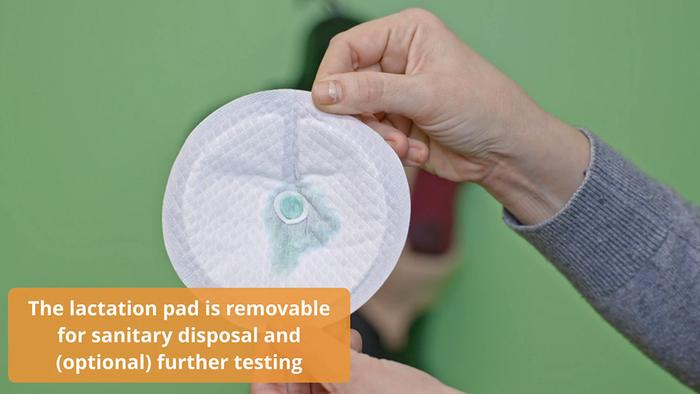Researchers at the University of Southern California (USC) have designed a lactation pad embedded with sensing technology that allows parents to monitor breast milk composition in real time. The pad can detect acetaminophen levels - a commonly prescribed painkiller after childbirth - ensuring the milk remains within safe limits for breastfeeding infants.
 The lactation pad is removable for sanitary disposal and could be used for further testing. Image Credit: Mousavi et al., Device
The lactation pad is removable for sanitary disposal and could be used for further testing. Image Credit: Mousavi et al., Device
Our device represents a major innovation. It is the first wearable tool for direct biochemical analysis in breast milk and the first lactation pad embedded with real-time sensing technology. This technology has the potential to empower lactating individuals with actionable health insights, supporting both maternal and infant health in ways that have never before been possible.
Maral Mousavi, Study First Author and Assistant Professor, Biomedical Engineering, University of Southern California
To create the device, the team integrated electrodes and microfluidic channels into a standard lactation pad - something many nursing parents already wear daily to prevent leaks from staining their clothes. The smart pad samples breast milk naturally as it leaks, analyzing it for traces of acetaminophen without requiring any additional action from the parent.
Because the pad tracks drug levels throughout the day, it also serves as a research tool to better understand how medications transfer into breast milk, Mousavi explained.
“While it is generally safe at recommended doses, acetaminophen overexposure is a leading cause of acute liver failure in children. It remains the most common reason for liver transplants related to drug toxicity,” added Mousavi.
The idea for the device came from personal experience within the lab. One of Mousavi’s graduate students was prescribed acetaminophen to manage postpartum pain after giving birth. That experience prompted the team to investigate how few tools currently exist to monitor breast milk safety in real time. While some commercial services offer mail-in testing kits, those options can be expensive and require parents to wait days or weeks for results.
Mousavi stated, “Given the risks and the critical decision-making parents face around breastfeeding and medication use, we wanted to create a tool that empowers them with real-time, personalized information rather than leaving them to rely on generalized drug-safety charts or delayed lab testing.”
The researchers hope this smart pad will help parents make more confident decisions, such as when to implement “pump and dump” strategies or discard milk during periods of high drug concentration.
Beyond acetaminophen, many new mothers are also prescribed antibiotics or antifungals - medications that are often considered safe during breastfeeding, though not without potential effects. The team sees potential to expand the technology to monitor a broader range of substances.
In fact, they’ve already developed another version of the pad that detects glucose levels in breast milk. Mousavi notes this could be especially useful for managing maternal nutrition or conditions like gestational diabetes.
Currently, the smart pad only works with milk that leaks naturally, which may limit its use for those who experience minimal leakage. Each pad is single-use, so a fresh one is needed for each new test. To improve accessibility, the researchers are now developing a version that can analyze pumped milk - a move they hope will make the technology more practical for everyday use.
Journal Reference:
Mohamed, M. A., et al. (2025) Safer breastfeeding with a wearable sensor for monitoring maternal acetaminophen transfer through breast milk. Device. doi.org/10.1016/j.device.2025.100774